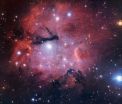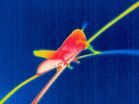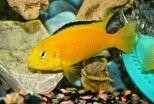(Press-News.org) This image was taken as part of the ESO Cosmic Gems programme [1] using the Wide Field Imager on the MPG/ESO 2.2-metre telescope at the La Silla Observatory in Chile. It shows Gum 15, located in the constellation of Vela (The Sails), some 3000 light-years from Earth [2]. This glowing cloud is a striking example of an HII region [3]. Such clouds form some of the most spectacular astronomical objects we can see; for example the Eagle Nebula (which includes the feature nicknamed "The Pillars of Creation"), the great Orion Nebula , and this less famous example, Gum 15.
Hydrogen (H) is the most common element in the Universe, and can be found in virtually every environment investigated by astronomers. HII regions are different because they contain substantial amounts of ionised hydrogen — hydrogen atoms that have been stripped of their electrons through high energy interactions with ultraviolet photons — particles of light. As the ionised hydrogen nuclei recapture electrons they release light at different characteristic wavelengths. It is one of these that gives nebulae such as Gum 15 their reddish glow — a glow which astronomers call hydrogen alpha (Hα).
In HII regions the ionising photons come from the young hot stars within the region, and Gum 15 is no exception. At the centre of this image you can see one of the culprits: the star HD 74804, the brightest member of a cluster of stars known as Collinder 197.
The clumpy, irregular appearance that enhances this nebula's beautyis not unusual for a HII region and is again a result of the stars within. HII regions have diverse shapes because the distribution of stars and gas inside them is so irregular. Adding to Gum 15's interesting shape are the forked dark patch of obscuring dust visible in the centre of this image and some dim blue reflection structures crossing it. This dust feature makes the nebula resemble a larger and fainter version of the better known Trifid Nebula (Messier 20), although in this case the name Bifid Nebula might be more apposite.
An HII region like this one might give birth to thousands of stars over a period of several million years. Some of these stars cause it to glow and sculpt its shape, and it is these stars that will eventually destroy it. Once the newly minted stars have passed through their infant stages, strong winds of particles will stream away from these large stars, sculpting and dispersing the gases around them, and when the most massive of these stars begin to die, Gum 15 will die with them. Some stars are so large that they will go out with a bang, exploding as supernovae and dispersing the regions last traces of HII, leaving behind just a cluster of infant stars.
INFORMATION:
Notes
[1] The ESO Cosmic Gems programme is an initiative to produce images of interesting, intriguing or visually attractive objects using ESO telescopes, for the purposes of education and public outreach. The programme makes use of telescope time that cannot be used for science observations. All data collected may also be suitable for scientific purposes, and are made available to astronomers through ESO's science archive.
[2] The name of this object comes from the Australian astronomer Colin Gum, who published a catalogue of HII regions in 1955.
[3] HII regions (pronounded "aitch-two") are large clouds of gas and dust that are host to bursts of star formation and homes to infant stars.
More information
ESO is the foremost intergovernmental astronomy organisation in Europe and the world's most productive ground-based astronomical observatory by far. It is supported by 15 countries: Austria, Belgium, Brazil, the Czech Republic, Denmark, France, Finland, Germany, Italy, the Netherlands, Portugal, Spain, Sweden, Switzerland and the United Kingdom. ESO carries out an ambitious programme focused on the design, construction and operation of powerful ground-based observing facilities enabling astronomers to make important scientific discoveries. ESO also plays a leading role in promoting and organising cooperation in astronomical research. ESO operates three unique world-class observing sites in Chile: La Silla, Paranal and Chajnantor. At Paranal, ESO operates the Very Large Telescope, the world's most advanced visible-light astronomical observatory and two survey telescopes. VISTA works in the infrared and is the world's largest survey telescope and the VLT Survey Telescope is the largest telescope designed to exclusively survey the skies in visible light. ESO is the European partner of a revolutionary astronomical telescope ALMA, the largest astronomical project in existence. ESO is currently planning the 39-metre European Extremely Large optical/near-infrared Telescope, the E-ELT, which will become "the world's biggest eye on the sky".
Links
* Photos of the MPG/ESO 2.2-metre telescope - http://www.eso.org/public/images/archive/search/?adv=&subject_name=mpg
* Other photos taken with the MPG/ESO 2.2-metre telescope - http://www.eso.org/public/images/archive/search/?adv=&facility=15
* Photos of La Silla - http://www.eso.org/public/images/archive/category/lasilla/
Contacts
Richard Hook
ESO, Public Information Officer
Garching bei München, Germany
Tel: +49 89 3200 6655
Cell: +49 151 1537 3591
Email: rhook@eso.org
A stellar womb shaped and destroyed by its ungrateful offspring
2014-07-02
ELSE PRESS RELEASES FROM THIS DATE:
'Deep learning' makes search for exotic particles easier
2014-07-02
Irvine, Calif. — Fully automated "deep learning" by computers greatly improves the odds of discovering particles such as the Higgs boson, beating even veteran physicists' abilities, according to findings by UC Irvine researchers published today in the journal Nature Communications.
"We are thrilled with the publication of our work," said co-author Pierre Baldi, Chancellor's Professor of computer science, "and even more so with the hope that deep learning may help solve fundamental open questions about the nature of matter, gravity and the origin of the universe."
Baldi, ...
Superconducting-silicon qubits
2014-07-02
Theorists propose a way to make superconducting quantum devices such as Josephson junctions and qubits, atom-by-atom, inside a silicon crystal. Such systems could combine the most promising aspects of silicon spin qubits with the flexibility of superconducting circuits. The researcher's results have now been published in Nature Communications (1).
High quality silicon is one of the historical foundations of modern computing. But it is also promising for quantum information technology. In particular, electron and nuclear spins in pure silicon crystals have been measured ...
From despair to repair: Dramatic decline of Caribbean corals can be reversed
2014-07-02
Gland, Switzerland – With only about one-sixth of the original coral cover left, most Caribbean coral reefs may disappear in the next 20 years, primarily due to the loss of grazers in the region, according to the latest report by the Global Coral Reef Monitoring Network (GCRMN), the International Union for Conservation of Nature (IUCN) and the United Nations Environment Programme (UNEP).
The report, Status and Trends of Caribbean Coral Reefs: 1970-2012, is the most detailed and comprehensive study of its kind published to date – the result of the work of 90 experts over ...
License plate readers are important police tool, but hurdles remain, study finds
2014-07-02
Systems that automatically read automobile license plates have the potential to save police investigative time and increase safety, but law enforcement officials must address issues related to staffing, compatibility and privacy before the technology can reach its full potential, according to a new RAND Corporation report.
As part of efforts to promote innovation in law enforcement, many of the first generation license plate reader systems were purchased with federal and state grants. As these funding streams can be inconsistent, law enforcement agencies are – or will ...
A 'magic moment' for unwed parents
2014-07-02
DURHAM, N.C. -- If unwed parents are going to get married, the best window of opportunity for that union seems to be before their child turns 3, says a new study from Duke University.
But patterns vary greatly by race, with more African-American mothers marrying much later than mothers of other races or ethnicities.
Federal policies have often presumed that unmarried parents will be most receptive to marriage right after a baby's birth, a period that has been dubbed the "magic moment." The new study is the first to test that assumption, said author Christina Gibson-Davis. ...
How do ants get around? Ultra-sensitive machines measure their every step…
2014-07-02
How do ants manage to move so nimbly whilst coordinating three pairs of legs and a behind that weighs up to 60% of their body mass? German scientists have recently developed a device that may reveal the answer.
Measuring the forces generated by single limbs is vital to understanding the energetics of animal locomotion. However, with very small animals such as insects, this becomes problematic. Dr Reinhardt (Friedrich-Schiller University) used an elastic polycarbonate material to produce a miniature force plate. Springs arranged at right angles to each other enabled forces ...
Locusts harness the sun to get their optimum diet
2014-07-02
If you are a locust, the most nutritious plant to eat depends on the ambient temperature. Scientists at the University of Sydney, Australia, have discovered that locusts choose their food and then where they digest it according to how hot it is.
Dr Fiona Clissold, who led the study, explains why temperature has such a large influence on insect diets. "Whilst an insect's metabolic rate increases exponentially with temperature, the rate at which locusts absorb protein and carbohydrate from different plants does not increase in step with temperature. As a result, nutrient ...
Smarter than you think: Fish can remember where they were fed 12 days later
2014-07-02
It is popularly believed that fish have a memory span of only 30 seconds. Canadian scientists, however, have demonstrated that this is far from true – in fact, fish can remember context and associations up to twelve days later.
The researchers studied African Cichlids (Labidochromis caeruleus), a popular aquarium species. These fish demonstrate many complex behaviours, including aggression, causing the scientists to predict that they could be capable of advanced memory tasks. Each fish was trained to enter a particular zone of the aquarium to receive a food reward, with ...
A sheep's early life experiences can shape behavior in later life
2014-07-02
New research has found that a sheep's experiences soon after birth can shape its later behaviour and also that of its offspring.
The study led by academics from the University of Bristol's School of Veterinary Sciences and published in the Royal Society journal Biology Letters investigated whether early-life experiences can alter behavioural responses to a naturally painful event in adulthood – giving birth – and also affect behaviour of the next generation.
The period following birth can be a challenging time for young lambs. They are usually tail-docked without analgesia ...
Patients with severe ME have little or no access to specialist treatment services
2014-07-02
One in three severely affected adults with ME in England have no access to local specialist services, new research has shown.
Published in the British Medical Journal Open, the research by the University of Southampton reveals NICE guidelines, which say severely affected patients with ME, otherwise known as chronic fatigue syndrome (CFS), should have access to specialist care, are not being met by many NHS Trusts across England.
Over a third of specialist adult ME/CFS services in the NHS provide no service to severely affected patients, and a further 12 per cent of ...



